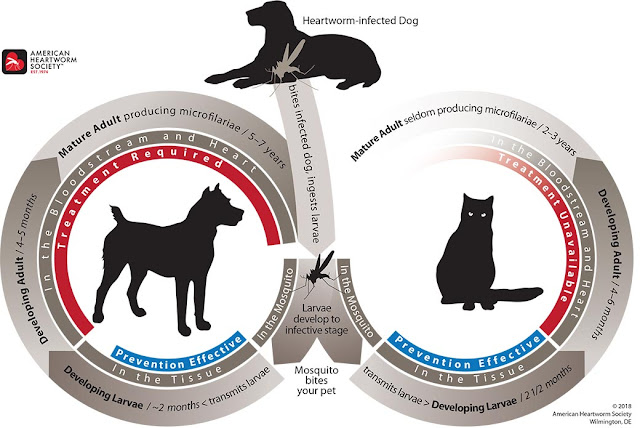Heartworm Disease. How big of a deal is this really? Well, if you live in the Southern states (where it's warm all the time and mosquitoes are present year-round) it is a HUGE deal. If you live in the Northern states this is still really important. Honestly, we Veterinarians in the North don’t diagnose this nearly as often as Veterinarians in the South, but I still see an increasing number of cases yearly. In this post, let’s talk about what Heartworm Disease is, how it is spread, symptoms you may see if your dog or cat has Heartworm Disease, and how to treat and prevent this disease.
What exactly is Heartworm Disease? This is a parasitic infection that your dog or cat can contract from mosquitoes. This little insect takes blood meals from mammals and then goes onto another mammal for its next blood meal. If the mosquito is carrying baby heartworms from the blood meal of one mammal, it will inject those baby heartworms under the skin of the next mammal it encounters. Creepy, right? These baby heartworms then travel through the bloodstream, finally making it to the heart and setting up home there. At that point these worms are larger and will continue their growth inside the heart.
There is typically a six month cycle in the development of heartworm disease that you will see in the image above. The larvae injected by the mosquito will develop into adult heartworms over the course of a couple months. You will also note in the image that if your dog or cat is taking monthly heartworm prevention, these larval stages of the worm can be killed. However, if your pet is not on a monthly preventative medication, after a few months, a different kind of treatment will be necessary.
If your dog has been bitten by a mosquito carrying heartworm larvae and is not on monthly prevention, what signs should you look for that may show your pet is developing Heartworm Disease? The first symptoms often seen are lethargy, coughing, and exercise intolerance. Sadly, pets can also suddenly die from Heartworm Disease. This disease may present very differently in dogs and cats. While dogs may have HUNDREDS of worms living in their heart with this disease, cats often only have a couple worms. Some cats can even clear the infection on their own, whereas in dogs, treatment is always needed for a cure. Below I have included an x-ray from a dog with heartworm disease. In these x-rays we often see an enlarged right side of the heart and inflammation in the lung tissue.
To diagnose Heartworm Disease in a dog or cat, we not only rely on x-rays, but more importantly, a snap test is available for diagnosis. This test only requires three drops of your pet’s blood, and 10 minutes of your time. Not only does this test look for Heartworm Disease in dogs, but also Lyme Disease (tick-borne), Ehrlichia (tick-borne), and Anaplasmosis (tick-borne). In cats, the test also looks for Feline Leukemia (blood disorder), and Feline Immunodeficiency Disease (Immune Disorder). They are great tests, and in dogs specifically, the test should be run EVERY YEAR. The best time to diagnose any of these diseases, is when your pet is ASYMPTOMATIC, meaning before they are showing symptoms of disease. This allows us Veterinarians to treat early and have a much better chance at a favorable outcome.
If your pet does test positive for Heartworm Disease, what do we do for treatment? I follow the treatment protocol on the American Heartworm Society website. A lot of research has gone into testing and treatment of this disease, and these recommendations for treatment have the best outcome. Treatment is not cheap, especially with a large breed dog. It consists of a month of antibiotics, followed by two or three injections, along with steroids. These injections are not only very costly but also very painful. I have treated many heartworm dogs, and they have done very well, but we always warn pet owners that during the course of treatment, the dog must be kept very restricted (sometimes in a crate for 6 weeks or more), and that sudden death is possible at any time during the treatment due to embolism from dying worms. SCARY stuff!
Wouldn’t it just be better to prevent Heartworm Disease from ever happening? Absolutely! Heartworm prevention is cheap, tasty, and very easy to administer. Many companies make chewable monthly preventatives, and some are even combination products, also protecting your dog from fleas and tick-borne diseases. It is so easy to prevent this horrible disease! So, if your pet is not currently on a Heartworm preventative, call your Veterinarian today to schedule their yearly heartworm test, and ask for monthly preventative to take home after your appointment. How often should you give this preventative? Every month, all year long. It’s what I do for my own dog, and recommend that everyone does it for their own pets as well.
What exactly is Heartworm Disease? This is a parasitic infection that your dog or cat can contract from mosquitoes. This little insect takes blood meals from mammals and then goes onto another mammal for its next blood meal. If the mosquito is carrying baby heartworms from the blood meal of one mammal, it will inject those baby heartworms under the skin of the next mammal it encounters. Creepy, right? These baby heartworms then travel through the bloodstream, finally making it to the heart and setting up home there. At that point these worms are larger and will continue their growth inside the heart.
 |
| Courtesy: American Heartworm Society |
There is typically a six month cycle in the development of heartworm disease that you will see in the image above. The larvae injected by the mosquito will develop into adult heartworms over the course of a couple months. You will also note in the image that if your dog or cat is taking monthly heartworm prevention, these larval stages of the worm can be killed. However, if your pet is not on a monthly preventative medication, after a few months, a different kind of treatment will be necessary.
If your dog has been bitten by a mosquito carrying heartworm larvae and is not on monthly prevention, what signs should you look for that may show your pet is developing Heartworm Disease? The first symptoms often seen are lethargy, coughing, and exercise intolerance. Sadly, pets can also suddenly die from Heartworm Disease. This disease may present very differently in dogs and cats. While dogs may have HUNDREDS of worms living in their heart with this disease, cats often only have a couple worms. Some cats can even clear the infection on their own, whereas in dogs, treatment is always needed for a cure. Below I have included an x-ray from a dog with heartworm disease. In these x-rays we often see an enlarged right side of the heart and inflammation in the lung tissue.
To diagnose Heartworm Disease in a dog or cat, we not only rely on x-rays, but more importantly, a snap test is available for diagnosis. This test only requires three drops of your pet’s blood, and 10 minutes of your time. Not only does this test look for Heartworm Disease in dogs, but also Lyme Disease (tick-borne), Ehrlichia (tick-borne), and Anaplasmosis (tick-borne). In cats, the test also looks for Feline Leukemia (blood disorder), and Feline Immunodeficiency Disease (Immune Disorder). They are great tests, and in dogs specifically, the test should be run EVERY YEAR. The best time to diagnose any of these diseases, is when your pet is ASYMPTOMATIC, meaning before they are showing symptoms of disease. This allows us Veterinarians to treat early and have a much better chance at a favorable outcome.
If your pet does test positive for Heartworm Disease, what do we do for treatment? I follow the treatment protocol on the American Heartworm Society website. A lot of research has gone into testing and treatment of this disease, and these recommendations for treatment have the best outcome. Treatment is not cheap, especially with a large breed dog. It consists of a month of antibiotics, followed by two or three injections, along with steroids. These injections are not only very costly but also very painful. I have treated many heartworm dogs, and they have done very well, but we always warn pet owners that during the course of treatment, the dog must be kept very restricted (sometimes in a crate for 6 weeks or more), and that sudden death is possible at any time during the treatment due to embolism from dying worms. SCARY stuff!
Wouldn’t it just be better to prevent Heartworm Disease from ever happening? Absolutely! Heartworm prevention is cheap, tasty, and very easy to administer. Many companies make chewable monthly preventatives, and some are even combination products, also protecting your dog from fleas and tick-borne diseases. It is so easy to prevent this horrible disease! So, if your pet is not currently on a Heartworm preventative, call your Veterinarian today to schedule their yearly heartworm test, and ask for monthly preventative to take home after your appointment. How often should you give this preventative? Every month, all year long. It’s what I do for my own dog, and recommend that everyone does it for their own pets as well.





Comments
Post a Comment